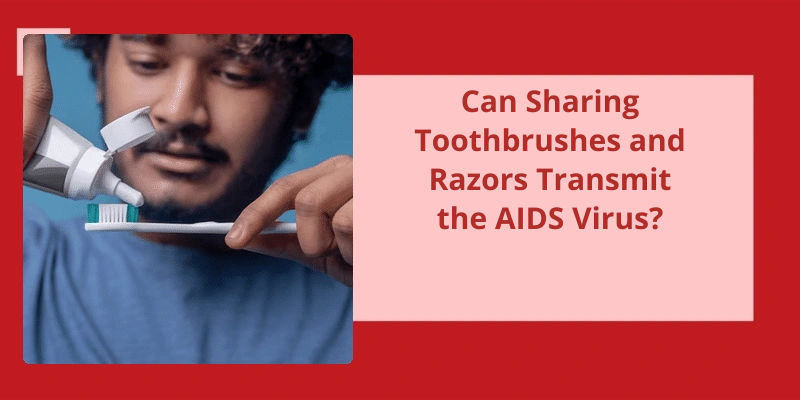The human immunodeficiency virus (HIV) is a dangerous infection that’s transmitted through body fluids like blood, semen, vaginal fluids, and breast milk. The virus targets and attacks the immune system, weakening it until it can no longer protect the body from infections and diseases. There are ways to reduce the risk of getting HIV, such as practicing safe sex and avoiding sharing needles and other equipment that have been used for injecting drugs. But what about sharing daily essentials like toothbrushes and razors? Can this seemingly harmless habit actually transmit the AIDS virus? While it’s extremely rare, there have been documented cases of HIV being transmitted through sharing razors and toothbrushes, particularly if infected blood from one person was deposited on the item and entered the bloodstream of another person.
Can AIDS Spread Through Toothbrush?
The idea that HIV/AIDS can be transmitted through the sharing of a toothbrush is a common myth. While it’s true that the virus can be found in bodily fluids such as saliva, the risk of transmission through this type of exposure is extremely low. The virus is fragile and isn’t able to survive outside the body for very long. This means that even if there’s some virus present on a toothbrush, the chances of it being infectious are very slim.
In addition, HIV isn’t easily transmitted from one person to another. The virus doesn’t spread on contact with skin, and it can’t be transmitted through casual contact such as shaking hands or hugging. It requires direct contact with infected bodily fluids, as mentioned earlier.
Unprotected sexual contact and the sharing of needles or other drug paraphernalia are two common routes of transmission. It’s also possible for a mother to pass the virus on to her baby during pregnancy, childbirth, or breastfeeding.
Prevention is key when it comes to HIV/AIDS. Using protection during sexual activity, avoiding the sharing of needles, and getting tested regularly can all help to reduce the risk of infection. For those who’re already living with HIV, taking antiretroviral medication as prescribed can help to suppress the virus and reduce the risk of transmission to others.
It’s important to focus on other means of transmission and to take steps to reduce the risk of infection. By educating ourselves and others about the facts surrounding HIV/AIDS, we can help to create a safer and healthier world for everyone.
It’s important to have accurate information about how AIDS is transmitted in order to reduce the stigma surrounding those living with the virus. Although there are various misconceptions, sharing combs isn’t a way of transmitting AIDS to others. However, there are still other precautions individuals living with AIDS should take to prevent the transmission of the virus to others.
Can AIDS Spread Through Comb?
This is a common myth that’s been circulating for years, but the truth is that HIV, the virus that causes AIDS, can’t survive outside of the body for very long. This means that even if an HIV-positive person used a comb and then handed it to someone else, the virus wouldn’t be able to infect that person.
The only way that HIV can be transmitted from one person to another is through specific bodily fluids, such as blood, semen, vaginal fluids, and breast milk. These fluids must come into contact with a mucous membrane or broken skin in order for transmission to occur. Sharing a comb wouldn’t provide the necessary conditions for HIV transmission.
In fact, HIV is a fragile virus that’s easily destroyed by a variety of factors, including exposure to air, heat, and even soap and water.
However, it’s important to note that there are other infectious diseases that can be spread through sharing combs, such as lice and skin infections. To prevent the spread of these illnesses, it’s important to practice good hygiene and avoid sharing personal items with others.
To sum up, the notion that AIDS can spread through combs is a myth and not based on scientific evidence. While there are other infections that can be spread through sharing combs, the risk of HIV transmission is extremely low. Education and awareness are key in dispelling myths and promoting accurate information about HIV and AIDS.
While HIV is primarily transmitted through sexual contact or needle sharing, it’s important to understand the ways in which this disease can be spread. However, the good news is that there are effective ways to reduce the risk of transmission and prevent the spread of HIV.
How Can AIDS Be Transmitted From One Person to Another?
One of the most significant ways that AIDS can be transmitted from one person to another is through unprotected sexual contact. This includes anal, oral, and vaginal sex, which can all lead to the exchange of bodily fluids that contain the virus. It’s recommended that individuals always use condoms during sexual activity to reduce the risk of transmission.
A mother can also transmit AIDS to her child during pregnancy, childbirth, or breastfeeding. Without proper medical care and treatment, the risk of transmission from mother to child can be as high as 45%. However, with appropriate medical care, the risk can be significantly reduced, and many mothers with HIV have been able to give birth to healthy, uninfected babies.
AIDS can also be transmitted through blood transfusions or organ transplants. However, in many countries, donated blood and organs are routinely screened for HIV before they’re used in medical procedures, which has greatly reduced the risk of transmission in these settings.
Finally, it’s important to remember that not all bodily fluids contain the virus that causes AIDS. HIV isn’t present in saliva, tears, urine, or sweat, so casual contact (such as hugging, shaking hands, or sharing food) doesn’t put individuals at risk of contracting the virus. It’s important to educate oneself about the ways that HIV can be transmitted in order to take appropriate precautions and protect oneself and others from infection.
Source: HIV Transmission | HIV Basics | HIV/AIDS | CDC
While there may still be misconceptions surrounding the transmission of AIDS, it’s important to note that the virus can’t be spread through casual contact such as sharing a hairbrush or getting a haircut. Research has shown that the chances of contracting HIV through a hair cut or shave are minimal, further debunking myths surrounding the transmission of the virus.
Does AIDS Spread Through Hair?
Acquired immunodeficiency syndrome (AIDS) has been a major public health concern since it’s discovery in the 1980s. The human immunodeficiency virus (HIV), which causes AIDS, is transmitted through blood, semen, vaginal fluids, and breast milk. However, there’s been some confusion and apprehension surrounding the transmission of HIV through hair.
The answer is no: HIV typically doesn’t spread through hair. Although hair is attached to the skin, HIV can’t survive outside the human body for more than a few minutes. Therefore, you don’t have to worry about catching HIV from a hair cut or shave.
It’s important to note that contaminated needles and other sharp objects that come into contact with blood are the most common means of HIV transmission. This is one of the reasons why tattoo parlors, needle-exchange programs, and healthcare facilities are usually required to follow strict sterilization and sanitation procedures to prevent spreading the virus. When it comes to hair salons and barbershops, they also follow stringent hygiene protocols to avoid the spread of infections.
As much as sharing is often encouraged, there are certain things that should never be shared, and hair brushes are one of them. According to Purvisha Patel, a board-certified dermatologist, hairbrushes are potential carriers of harmful microbes and contaminants, making them a risky item to share – even among family members. In the next section, we’ll delve into some of the dangers of sharing hairbrushes.
Can Sharing a Hair Brush Spread?
Many people may not realize the potential risks associated with sharing a hairbrush. Hairbrushes can accumulate a variety of bacteria, dead skin cells, and other debris from everyday use. When multiple individuals use the same brush, there’s a higher risk of transferring these contaminants from person to person. This can be especially concerning if an individual has an infection or condition that can be spread through contact.
One common example of a condition that can be spread through shared hairbrushes is head lice. These tiny insects can easily cling to hair strands and lay eggs on scalps. If an individual with head lice uses a shared hairbrush, the lice can be transferred to another persons hair. This can lead to an infestation and a difficult process to eradicate the lice.
This includes fungal infections like ringworm and skin conditions like psoriasis. Even individuals who don’t have visible symptoms of an infection or condition can still harbor microbes on their hair and scalp.
For individuals who regularly visit salons and spas, it’s important to ensure that the salon operates with proper hygiene practices and sanitizes tools between clients. By taking these precautions, individuals can keep their hair and scalp healthy and avoid unnecessary risk of infection and spread of contagion.
The Difference Between Natural and Synthetic Bristle Hairbrushes and Their Impact on Hygiene
- Natural bristle hairbrushes are made from animal hair, such as boar or horsehair.
- Synthetic bristle hairbrushes are made from man-made materials, such as nylon or plastic.
- Natural bristle hairbrushes can be more gentle on the scalp and hair, but may not be as durable as synthetic bristle hairbrushes.
- Synthetic bristle hairbrushes are generally more affordable and long-lasting, but may not provide the same level of scalp stimulation and conditioning as natural bristle hairbrushes.
- Hygiene-wise, synthetic bristle hairbrushes are easier to clean and maintain, while natural bristle hairbrushes require more care and attention to maintain their quality and longevity.
Conclusion
However, it’s important to note that the risk of HIV transmission through sharing razors and toothbrushes is extremely low. While it’s always safer to use your own personal hygiene items, it’s important not to panic or discriminate against individuals living with HIV. The best way to prevent HIV transmission is through safe sex practices, getting tested regularly, and being informed about HIV transmission risks. It’s crucial to spread accurate information and increase awareness in order to prevent the spread of HIV and eliminate stigma surrounding those living with the virus. We must approach HIV education and prevention with compassion and evidence-based solutions to create a healthier and more inclusive society.






